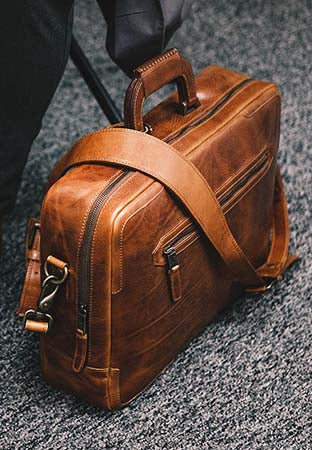Leather crafting is an art form that is a testament to the ingenuity and skill of artisans who manipulate this versatile material into objects of both utility and beauty. Among the numerous techniques that elevate leather from mere fabric to exquisite art, stitching holds a place of particular admiration.
The Evolution of Leather Stitching
From its earliest inception, leather has played a pivotal role in human society, serving practical needs for clothing, shelter, and tools while evolving into a medium of artistic expression and craftsmanship.
Leatherworking dates back to the Paleolithic era, when it initially revolved around using animal hides for clothing and shelter. As civilizations advanced, so did the techniques for processing and embellishing leather. The development of tanning methods was among the earliest innovations to transform raw hides into durable, workable materials.
By the 11th to 15th centuries, leather artistry had reached new heights with complex techniques like embossing and carving. These practices demonstrated skill and elevated leatherwork into decorative art, showcasing the material's versatility and beauty.
Transition from Hand Stitching to Machine Stitching
Initially, all leather goods were hand-stitched. Although time-consuming, hand-stitching allowed for precision and durability.
However, the Industrial Revolution introduced machine stitching and significantly altered the landscape of leather crafting. Machine stitching offered efficiency and uniformity, enabling mass production of leather goods for the first time. This shift departed from the artisanal, bespoke approach of hand stitching, favoring speed and scalability instead.
Resurgence of Handcrafted Leather Goods
Despite the dominance of machines, recent years have witnessed a resurgence in the appreciation for handcrafted leather goods. This revival is fueled by consumer interest in sustainable, ethically produced items with a unique, personal touch.
For instance, at Will Leather Goods, we have a “tip-to-tail” philosophy that ensures we honor each leather piece by creating zero leather waste.
The tactile quality, durability, and individual character of hand-created leather goods starkly contrast with the often impersonal nature of mass-produced items. This has led many to rediscover the value of traditional leatherworking craftsmanship.
Stitch Patterns and Techniques

Stitch patterns and techniques in leather crafting serve the functional purpose of joining pieces together and contribute significantly to the aesthetic appeal of the final product.
Saddle Stitch
- This is one of the strongest and most common stitches used in leatherworking. It involves using two needles on opposite ends of a single thread to stitch through the same holes from opposite directions.
- Ideal for creating durable seams on wallets, belts, and bags.
Running Stitch
- A basic stitch where the thread runs in and out of the leather in a straight line.
- Often used for decorative purposes or basting leather pieces together temporarily.
Backstitch
- This stitch involves making two forward stitches and returning one, reinforcing the line for strength.
- Used at the start and end of a stitch line to lock stitches in place, especially in areas that experience tension.
Whip Stitch (or Overstitch)
- In this stitch, the needle wraps around the edge of the leather, creating a loop or "whip" effect on the edges.
- Commonly used for edging or joining two pieces of leather at the edges, such as in the case of leather patches or repairs.
Blanket Stitch
- Similar to the whip stitch but with a knot at each entry point.
- Often used for decorative edging on leather edges.
Cross Stitch
- This stitch involves creating an X shape at each stitch point, passing the needle diagonally over an intersection of leather pieces.
- Ideal for decorative purposes, joining two pieces of leather, or reinforcing areas subject to strain.
Box Stitch
- Used to join two pieces of leather at a 90-degree angle, it involves stitching in a box shape and often includes a diagonal stitch across the box for added strength.
- Seen in constructing leather boxes, cases, or any structure requiring right-angle joins.
Overcast Stitch
- A simple edge stitch that wraps around the edge of the leather to prevent fraying.
- Used for finishing edges, especially on thinner or more delicate leathers.
Chain Stitch
- A series of looped stitches that form a chain-like pattern.
- Often used for decorative edging and detailing on leather goods.
Pricking Stitch (or Prick Stitch)
- This involves making small stitches visible on the surface, with most of the thread hidden inside the seam. It's achieved by using a pricking iron to mark evenly spaced holes before stitching.
- Employed for decorative purposes, especially on high-end leather goods where the appearance of the stitches is as important as their functionality.
Preparing for Stitching
The journey of crafting a leather wallet, belt, or purse begins long before the first stitch is made. Preparing leather for stitching is a meticulous process that sets the stage for the finished product's durability, aesthetics, and quality.
Preparing the Leather Pieces
The initial step in preparing leather for stitching involves selecting the right leather in terms of thickness and quality. The choice of leather impacts the ease of stitching and the final look and feel of the product.
We use full-grain, top-grain, and vegetable-tanned leather for our pieces. Each type of leather has its own unique individuality, from appearance to aging, so we select the leather based on the needs of our designs.
Once the appropriate leather is chosen, the next step is to cut and align the leather pieces accurately. Precision in cutting ensures that the pieces fit together seamlessly, a crucial factor in the item's appearance and integrity.
Aligning the leather pieces correctly after cutting is paramount. Even the finest stitches can't compensate for misaligned pieces, which could detract from the final product's aesthetic and functionality.
Marking and Punching Stitch Holes
Before the actual stitching begins, marking and punching stitch holes is an important preparation step.
This process starts with using a divider to ensure consistent spacing of stitch lines. Consistent stitch lines are about more than just visual appeal. They also contribute to the even distribution of stress across the seam to enhance the durability of the leather item.
After marking, the next phase is to punch or prepare stitch holes. The goal is to create clean, uniform holes accommodating the stitching thread. This preparation is important for smooth stitching and contributes significantly to the final product's strength and elegance.
Mastering the Stitch
The artistry of a leather worker is rooted in an intricate understanding and mastery of stitching, a foundational skill that transforms simple leather pieces into exquisite, durable goods.
Crafting with Strength and Consistency
For a leather worker, mastering the stitch begins with an intimate knowledge of the tools and materials.
Threading needles are performed precisely to ensure the thread is neither too tight nor loose. Stitch strength and consistency are not just a matter of technique but of understanding the material's behavior under different conditions.
Leatherworkers are adept at selecting the right type of thread based on the leather's thickness and the intended use of the final product. They also know which stitches to employ that complement the leather's natural strength to enhance its durability and aesthetic appeal.
Stitching with Precision
Avoiding common mistakes – such as tangled thread or uneven spacing – is second nature to seasoned leather workers. They navigate these challenges by employing tricks of the trade learned through years of experience.
Whether using a stitching pony to stabilize the workpiece or applying beeswax to the thread for smooth sewing, each technique contributes to the quality of the finished product.
Finishing Touches
A leather worker's job doesn't end with the last stitch. Finishing touches are what elevate a piece from good to exceptional.
Backstitching, for example, is meticulously done to secure the ends and ensure stitches don't come undone with use. Threads are also trimmed and sealed to leave no loose ends that could mar the item's appearance.
This attention to detail defines the essence of high-quality leatherwork, distinguishing handcrafted goods from mass-produced items in a market flooded with them.
Celebrating the Craft of Leather Stitching

In observing the craft of leather stitching, we honor the artistry and passion of artisans past and present, embracing the beauty and durability they put into each leather good they create.
Discover this beauty for yourself by exploring our leather collection today.











